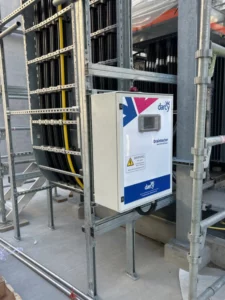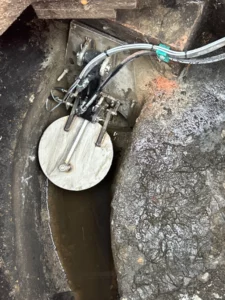
Oil-filled transformers are used within electrical power systems on sites across the world where high-voltage power distribution is required.
Transformers are used in various industries including:
- Power plants and substations for voltage regulation and to step up or down voltage
- Heavy industry and manufacturing, where power reliability is crucial
- Oil and gas industry to regulate power needed for complex processes
- Data centres and IT infrastructure to provide stable and efficient power conversion
- Airports to power critical infrastructure like runway lighting and terminals
- Wind farms – step-up transformers used to connect power to the grid.
There’s a large focus on sustainability within all industries. The need to balance demand with the environmental impact, including power and water consumption, is a hot topic.
Pollution Risks Associated With Sites With Transformers
Part of creating sustainable industrial practices is minimising the risk to the environment. Legislation is in place to mitigate the impact of industry on the environment, including rules around the discharge of water and pollutants.
The risk of a pollution incident at a site comes from the storage of hydrocarbons, such as oil within transformers, and the risk of fire, which could result in contaminated firewater escaping into drains.
Firms can be fined up to 100% of their annual profits for causing a pollution incident. In addition to fines, businesses are liable for clean-up and remediation costs, plus there’s the risk of reputational damage and negative PR that could affect your bottom line.
Insurance may help cover costs, but it’s essential that businesses follow best practices for pollution prevention. If an incident occurs and it transpires that best practices were not followed, insurance companies may not pay out.
Tertiary Containment Requirements
With the correct leak and fire prevention in place, the risks should be low to medium, however, a thorough risk assessment of the site needs to take place to ascertain whether tertiary containment is required.
Tertiary containment is defined by CIRIA C736:
“Minimises the consequences of a failure in the primary and secondary containment systems. Tertiary containment will be used when there is an event that causes the escape of liquids from the secondary containment through failure or overflow (e.g. bund joint failure, or firewater overflowing from a bund or escaping from a building during a prolonged fire).”
What Are Drain Closure Systems?
Drain closure systems are a form of tertiary containment that are designed to effectively seal drains within seconds to retain spillages or firewater within your site’s drainage system. They are your last defence for containing pollutants.
Drain closure devices enable you to isolate part or the whole of your site. Depending on the system you choose, they can run self-diagnostic checks and offer a full reporting system so that you can monitor the health of your system.
Benefits of Drain Closure Systems for Transformers
The main reasons to install drain closure systems at sites with oil-filled transformers are to prevent discharging pollution into the watercourse and to be compliant with CIRIA Containment systems for the prevention of pollution (C736) best practice guidelines. The guidance has been established to prevent pollution incidents and mitigate risk to the environment.
Compliance with guidance proves your environmental responsibility and gives you peace of mind that, should the worst happen, your site’s security will not be compromised. If you need to deploy your drain closure devices, the isolated nature of the spill will make clean-up quicker and allow you to continue day-to-day operations as swiftly as possible – especially pertinent for sites that need to maintain 100% uptime.
Benefits of Drain Closure Devices From Aquasentry
- Cost-effective
- Minimal civil works required
- Can be retrofitted into the existing drainage network
- Manual or automated deployment
- Choice of probes and alert systems
- Bespoke, consultative approach to ensure the correct specification for your site.
Types of Drain Closure Systems
Draintector Drain Shut Off Valve

Draintector comprises a multi-inflationary bladder unit that sits within the site drainage system and an above-ground control panel. The Draintector doesn’t affect flow in normal conditions. It can be activated manually or automatically by sensors or fire alarms. When deployed, the bladder expands and seals the drain, ensuring no pollutants or firewater runoff pass through.
Draintector is cost-effective when compared against other devices, such as penstocks and mechanical gates, and minimal maintenance is required. It’s ideal for sites of potential low usage that have drains up to 15” (380mm) with low heads of water.
The flexible bladder valve enables installation in an awkward-shaped discharge point or where access to the drain for a conventional valve system would result in significant civil works.
Read more about Draintector drain shut off valves
Hydraulic Drain Closure Valve

The hydraulic valve is a hydraulically activated unit with a patented overlocking toggle system that can only be disabled by either manual intervention or a GSM deactivation, ensuring an uncompromised seal of the area. The hydraulic valve can be deployed automatically or manually. Its unique adaptor plate can be fitted onto an existing flange or to the wall within a chamber.
The hydraulic drain closure valve can be built into your drainage system during installation or retrofit with minimal civil works. The system is built to your specifications whilst remaining low-cost.
Read more about hydraulic drain closure valves
Key Features to Consider
When choosing drain closure devices for your site, you need to consider the key features of each model. With Aquasentry, we do the hard work for you by visiting your site and making recommendations. The site survey enables us to work closely with our customers to ensure the best solution.
Both the Draintector and the hydraulic check valve are easy to install with minimal disruption to operations.
Several probes and detection devices can be included with your installation, including pH monitoring, level alarms, and excessive oil, turbidity and glycol sensors. The drain closure devices can be set up with automated activation through sensors, your fire alarm, business management system or remote device. Automated drain closure is vital for large sites where the control centre can be a mile or more from the site of an incident. Automated activation removes the need for human intervention and ensures the drains are sealed within seconds.
Your existing infrastructure may determine which product best suits your needs. Draintector is suitable for use at depths down to 2.5m and with pipes up to 300mm in diameter. The hydraulic valve can be used down to 15m and in pipes up to 1m in diameter. The types of chemicals that are stored on your site can affect the material used for the valve. During the site visit, our chemist will take samples of any chemicals and test them against the materials we use in the construction of our devices. This ensures the seal will not be damaged.

Prevent Pollution Incidents at Site Utilising Oil-Filled Transformers
As all industries are under scrutiny for their environmental impact, your site mustn’t pollute the environment through pollution incidents. Drain closure devices are designed to comply with CIRIA C376 guidelines for tertiary containment and isolate pollution within your site before it reaches the watercourse.
Following best practices for oil storage and installing drain closure devices will prevent pollution incidents and subsequent Environment Agency enforcement, which can include unlimited fines and remediation costs.
Once you’ve compared our drain closure devices, get in touch to discuss how we can help prevent pollution incidents at your site.
FAQs
Q: How long does it take for drain closure systems to be installed?
A: The length of time it takes to install drain closure devices depends on a variety of factors, including the number of devices being installed, whether any civil works need to be carried out, etc. On average, it takes 8 hours to install one Draintector drain closure system.
Our engineers always aim to install drain closure systems with the least amount of disruption possible to your operations.
Q: How much do drain closure systems cost?
A: Every drain closure system is a bespoke solution designed to suit the specific requirements of your site. One closure device can be supplied and installed for as little as £5,000. Once we’ve spoken to you to understand your needs and site, we’ll be able to give you a clear indication of the price for the whole project at your location. Rest assured, we will work with you to find the best solution. It’s our consultative approach that sets us apart from others.
Q. What’s the process for installing drain closure systems?
A: The first step is always to understand your requirements. This will include a site visit so that we can devise a bespoke solution to suit your unique site needs. Upon return to the office, the project will be fully costed and the proposal sent out to you. Once everything is agreed and planned out, our team of engineers will install the drain closure devices, and we’ll arrange an ongoing servicing agreement to keep your system in good working order and compliant.
Q: Do you install drain closure systems outside of the UK?
A: Yes, we work across the UK and Europe. Some of our recent projects have seen us install drain closure systems in the Netherlands, Sweden and Ireland.
Q: How often do drain closure systems need to be maintained?
A: To align with best practices, we recommend annual maintenance of closure devices. During the service, our engineers will ensure the drain closure system is working effectively and efficiently, so that you can be assured that it’ll work as expected when you need it to.
Any sensors within the system must be maintained annually in line with BS EN 858 – 1 & – 2 58.
Our Expert Says
“Bunded areas and spill kits remain essential for environmental compliance, but the focus is shifting to identifying outfalls and preventing pollution at the source. The only foolproof solution is installing closure devices.
“Automated drain closure systems provide peace of mind, securing sites and protecting staff in emergencies. Many clients pursue these solutions for ISO 14001 or 18001 compliance, also to conform with best practice for COMAH sites, risk mitigation, and reputational protection. With fines now potentially matching company profits, investing in prevention is becoming the only viable option.
“We help clients implement best practices because as long as you’ve got open drainage systems, you are vulnerable.”
Kirk Meikle, Technical Sales Director
Further Information
To enquire about drain closure systems, get in touch with our expert team today.
Table of Contents
Sign up for the latest news and offers


